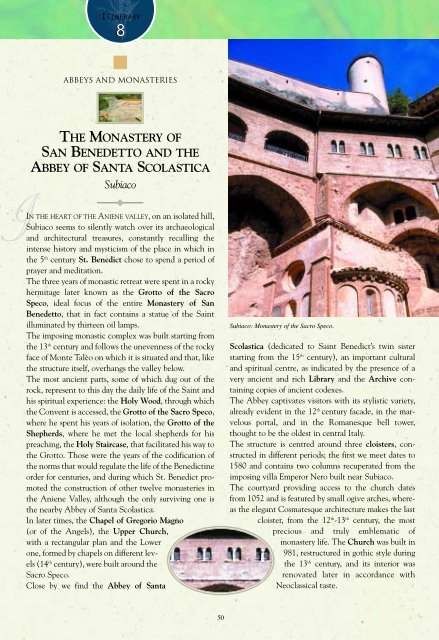Walking through time Walking through time - IBAM
Walking through time Walking through time - IBAM
Walking through time Walking through time - IBAM
You also want an ePaper? Increase the reach of your titles
YUMPU automatically turns print PDFs into web optimized ePapers that Google loves.
ITINERARY<br />
8<br />
ABBEYS AND MONASTERIES<br />
THE MONASTERY OF<br />
SAN BENEDETTO AND THE<br />
ABBEY OF SANTA SCOLASTICA<br />
Subiaco<br />
IN THE HEART OF THE ANIENE VALLEY, on an isolated hill,<br />
Subiaco seems to silently watch over its archaeological<br />
and architectural treasures, constantly recalling the<br />
intense history and mysticism of the place in which in<br />
the 5 th century St. Benedict chose to spend a period of<br />
prayer and meditation.<br />
The three years of monastic retreat were spent in a rocky<br />
hermitage later known as the Grotto of the Sacro<br />
Speco, ideal focus of the entire Monastery of San<br />
Benedetto, that in fact contains a statue of the Saint<br />
illuminated by thirteen oil lamps.<br />
The imposing monastic complex was built starting from<br />
the 13 th century and follows the unevenness of the rocky<br />
face of Monte Talèo on which it is situated and that, like<br />
the structure itself, overhangs the valley below.<br />
The most ancient parts, some of which dug out of the<br />
rock, represent to this day the daily life of the Saint and<br />
his spiritual experience: the Holy Wood, <strong>through</strong> which<br />
the Convent is accessed, the Grotto of the Sacro Speco,<br />
where he spent his years of isolation, the Grotto of the<br />
Shepherds, where he met the local shepherds for his<br />
preaching, the Holy Staircase, that facilitated his way to<br />
the Grotto. Those were the years of the codification of<br />
the norms that would regulate the life of the Benedictine<br />
order for centuries, and during which St. Benedict promoted<br />
the construction of other twelve monasteries in<br />
the Aniene Valley, although the only surviving one is<br />
the nearby Abbey of Santa Scolastica.<br />
In later <strong>time</strong>s, the Chapel of Gregorio Magno<br />
(or of the Angels), the Upper Church,<br />
with a rectangular plan and the Lower<br />
one, formed by chapels on different levels<br />
(14 th century), were built around the<br />
Sacro Speco.<br />
Close by we find the Abbey of Santa<br />
Subiaco: Monastery of the Sacro Speco.<br />
Scolastica (dedicated to Saint Benedict’s twin sister<br />
starting from the 15 th century), an important cultural<br />
and spiritual centre, as indicated by the presence of a<br />
very ancient and rich Library and the Archive containing<br />
copies of ancient codexes.<br />
The Abbey captivates visitors with its stylistic variety,<br />
already evident in the 12 th century facade, in the marvelous<br />
portal, and in the Romanesque bell tower,<br />
thought to be the oldest in central Italy.<br />
The structure is centred around three cloisters, constructed<br />
in different periods; the first we meet dates to<br />
1580 and contains two columns recuperated from the<br />
imposing villa Emperor Nero built near Subiaco.<br />
The courtyard providing access to the church dates<br />
from 1052 and is featured by small ogive arches, whereas<br />
the elegant Cosmatesque architecture makes the last<br />
cloister, from the 12 th -13 th century, the most<br />
precious and truly emblematic of<br />
monastery life. The Church was built in<br />
981, restructured in gothic style during<br />
the 13 th century, and its interior was<br />
renovated later in accordance with<br />
Neoclassical taste.<br />
50
















